ITECH7409: A Detailed Report on IEEE Software Testing Standards
VerifiedAdded on 2023/06/12
|8
|1997
|167
Report
AI Summary
This report provides a detailed analysis of IEEE software testing standards, focusing on their application and relevance in ensuring software quality. It examines key aspects such as the scope and intent of the standards, the entities holding copyright, and essential terms like quality assurance and component testing. The report also discusses the commonalities and differences between ANSI/IEEE standards 829:1983 and 1008:1987, highlighting their importance in establishing consistent and universally understood protocols. The conclusion emphasizes the need for objective, practical, and risk-matched testing approaches to enhance software quality, advocating for methodologies that provide tangible evidence of software reliability. Desklib offers a wide range of resources, including past papers and solved assignments, to support students in their academic endeavors.
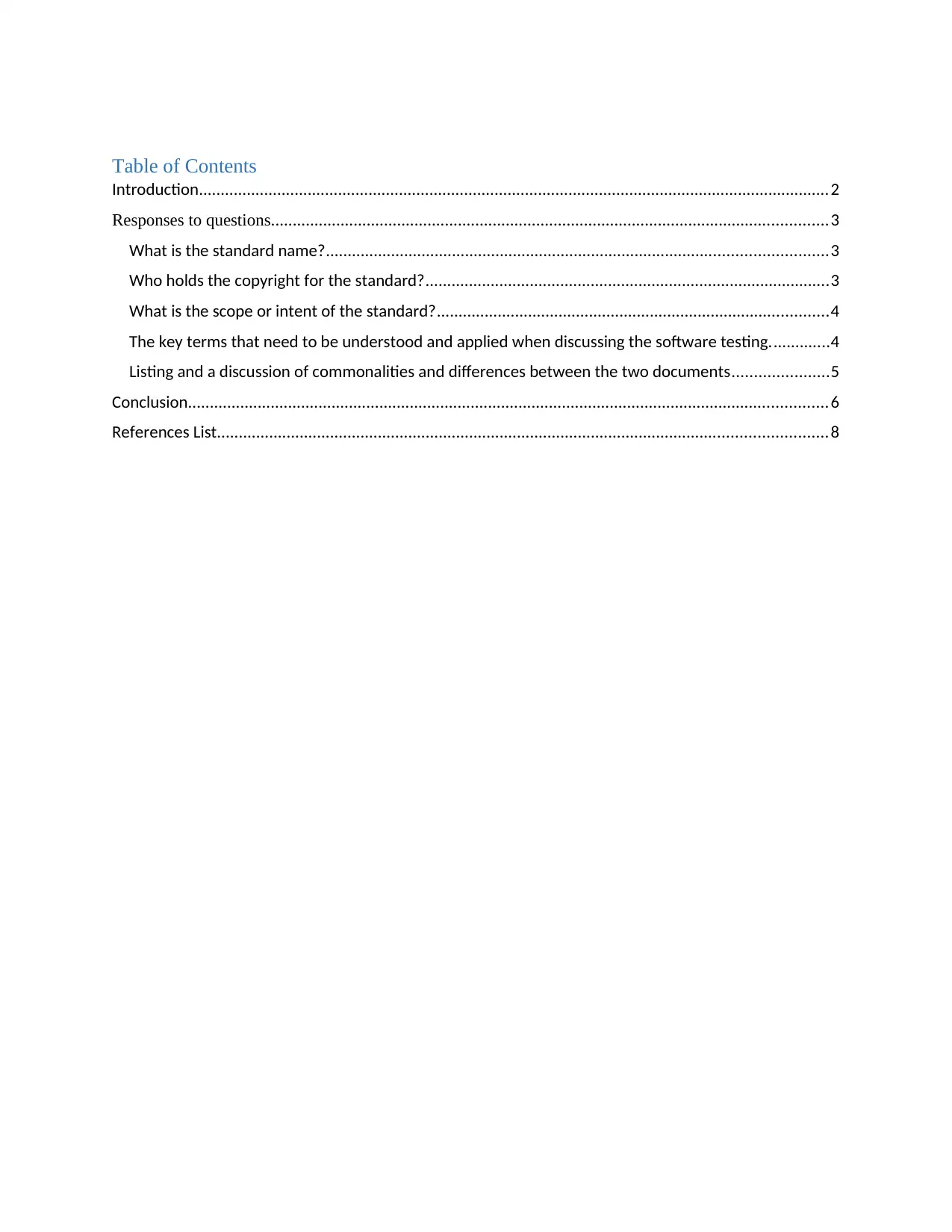
Table of Contents
Introduction.................................................................................................................................................2
Responses to questions................................................................................................................................3
What is the standard name?...................................................................................................................3
Who holds the copyright for the standard?.............................................................................................3
What is the scope or intent of the standard?..........................................................................................4
The key terms that need to be understood and applied when discussing the software testing..............4
Listing and a discussion of commonalities and differences between the two documents......................5
Conclusion...................................................................................................................................................6
References List............................................................................................................................................8
Introduction.................................................................................................................................................2
Responses to questions................................................................................................................................3
What is the standard name?...................................................................................................................3
Who holds the copyright for the standard?.............................................................................................3
What is the scope or intent of the standard?..........................................................................................4
The key terms that need to be understood and applied when discussing the software testing..............4
Listing and a discussion of commonalities and differences between the two documents......................5
Conclusion...................................................................................................................................................6
References List............................................................................................................................................8
Paraphrase This Document
Need a fresh take? Get an instant paraphrase of this document with our AI Paraphraser
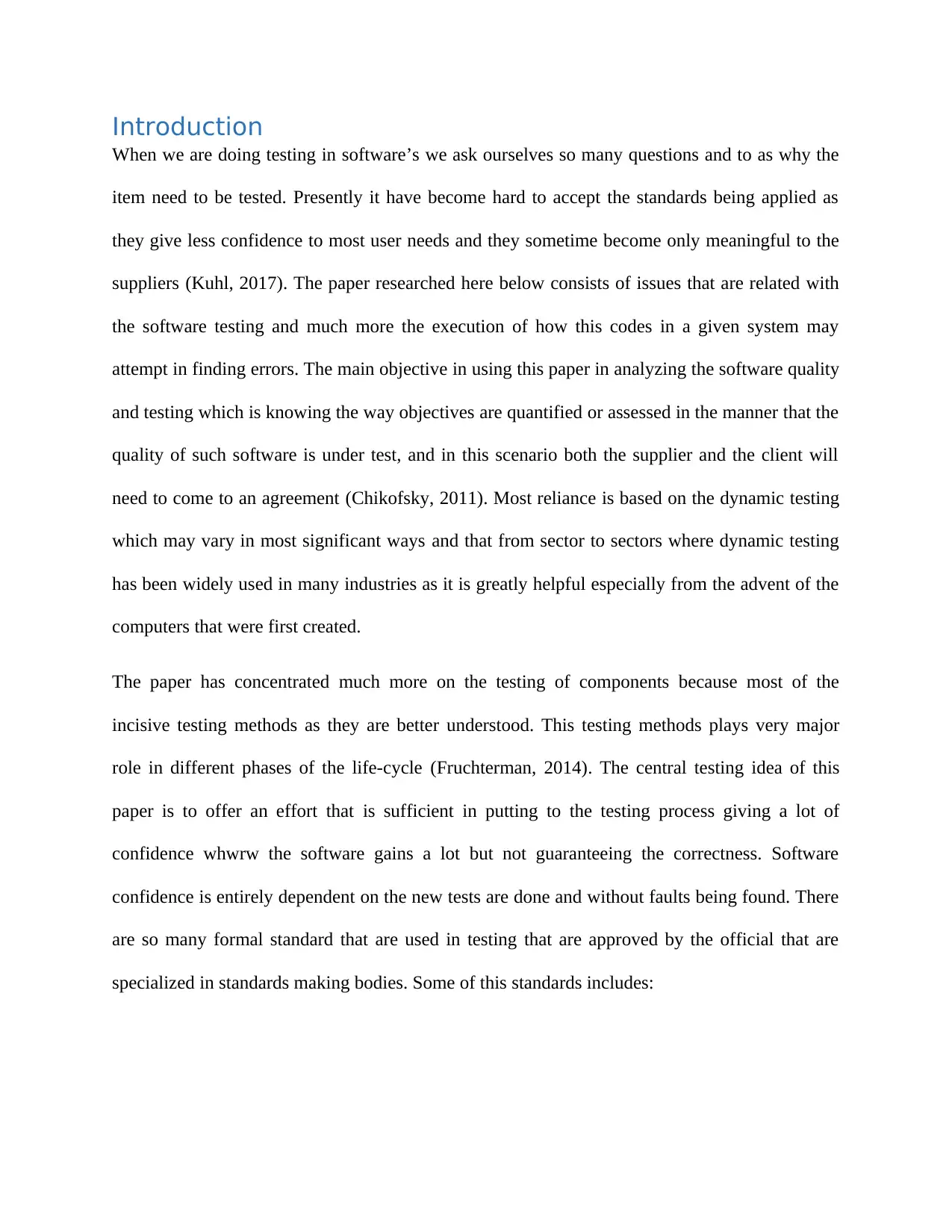
Introduction
When we are doing testing in software’s we ask ourselves so many questions and to as why the
item need to be tested. Presently it have become hard to accept the standards being applied as
they give less confidence to most user needs and they sometime become only meaningful to the
suppliers (Kuhl, 2017). The paper researched here below consists of issues that are related with
the software testing and much more the execution of how this codes in a given system may
attempt in finding errors. The main objective in using this paper in analyzing the software quality
and testing which is knowing the way objectives are quantified or assessed in the manner that the
quality of such software is under test, and in this scenario both the supplier and the client will
need to come to an agreement (Chikofsky, 2011). Most reliance is based on the dynamic testing
which may vary in most significant ways and that from sector to sectors where dynamic testing
has been widely used in many industries as it is greatly helpful especially from the advent of the
computers that were first created.
The paper has concentrated much more on the testing of components because most of the
incisive testing methods as they are better understood. This testing methods plays very major
role in different phases of the life-cycle (Fruchterman, 2014). The central testing idea of this
paper is to offer an effort that is sufficient in putting to the testing process giving a lot of
confidence whwrw the software gains a lot but not guaranteeing the correctness. Software
confidence is entirely dependent on the new tests are done and without faults being found. There
are so many formal standard that are used in testing that are approved by the official that are
specialized in standards making bodies. Some of this standards includes:
When we are doing testing in software’s we ask ourselves so many questions and to as why the
item need to be tested. Presently it have become hard to accept the standards being applied as
they give less confidence to most user needs and they sometime become only meaningful to the
suppliers (Kuhl, 2017). The paper researched here below consists of issues that are related with
the software testing and much more the execution of how this codes in a given system may
attempt in finding errors. The main objective in using this paper in analyzing the software quality
and testing which is knowing the way objectives are quantified or assessed in the manner that the
quality of such software is under test, and in this scenario both the supplier and the client will
need to come to an agreement (Chikofsky, 2011). Most reliance is based on the dynamic testing
which may vary in most significant ways and that from sector to sectors where dynamic testing
has been widely used in many industries as it is greatly helpful especially from the advent of the
computers that were first created.
The paper has concentrated much more on the testing of components because most of the
incisive testing methods as they are better understood. This testing methods plays very major
role in different phases of the life-cycle (Fruchterman, 2014). The central testing idea of this
paper is to offer an effort that is sufficient in putting to the testing process giving a lot of
confidence whwrw the software gains a lot but not guaranteeing the correctness. Software
confidence is entirely dependent on the new tests are done and without faults being found. There
are so many formal standard that are used in testing that are approved by the official that are
specialized in standards making bodies. Some of this standards includes:
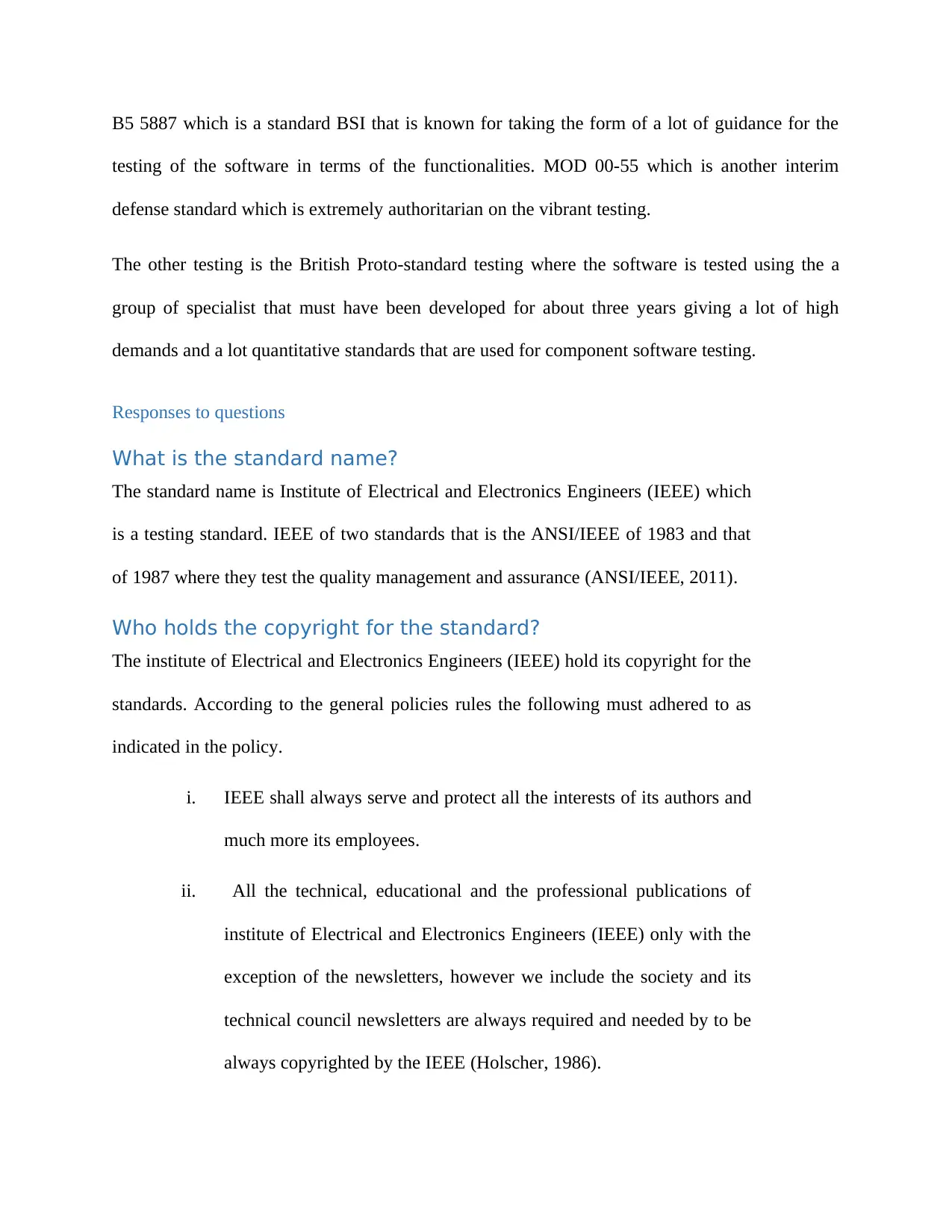
B5 5887 which is a standard BSI that is known for taking the form of a lot of guidance for the
testing of the software in terms of the functionalities. MOD 00-55 which is another interim
defense standard which is extremely authoritarian on the vibrant testing.
The other testing is the British Proto-standard testing where the software is tested using the a
group of specialist that must have been developed for about three years giving a lot of high
demands and a lot quantitative standards that are used for component software testing.
Responses to questions
What is the standard name?
The standard name is Institute of Electrical and Electronics Engineers (IEEE) which
is a testing standard. IEEE of two standards that is the ANSI/IEEE of 1983 and that
of 1987 where they test the quality management and assurance (ANSI/IEEE, 2011).
Who holds the copyright for the standard?
The institute of Electrical and Electronics Engineers (IEEE) hold its copyright for the
standards. According to the general policies rules the following must adhered to as
indicated in the policy.
i. IEEE shall always serve and protect all the interests of its authors and
much more its employees.
ii. All the technical, educational and the professional publications of
institute of Electrical and Electronics Engineers (IEEE) only with the
exception of the newsletters, however we include the society and its
technical council newsletters are always required and needed by to be
always copyrighted by the IEEE (Holscher, 1986).
testing of the software in terms of the functionalities. MOD 00-55 which is another interim
defense standard which is extremely authoritarian on the vibrant testing.
The other testing is the British Proto-standard testing where the software is tested using the a
group of specialist that must have been developed for about three years giving a lot of high
demands and a lot quantitative standards that are used for component software testing.
Responses to questions
What is the standard name?
The standard name is Institute of Electrical and Electronics Engineers (IEEE) which
is a testing standard. IEEE of two standards that is the ANSI/IEEE of 1983 and that
of 1987 where they test the quality management and assurance (ANSI/IEEE, 2011).
Who holds the copyright for the standard?
The institute of Electrical and Electronics Engineers (IEEE) hold its copyright for the
standards. According to the general policies rules the following must adhered to as
indicated in the policy.
i. IEEE shall always serve and protect all the interests of its authors and
much more its employees.
ii. All the technical, educational and the professional publications of
institute of Electrical and Electronics Engineers (IEEE) only with the
exception of the newsletters, however we include the society and its
technical council newsletters are always required and needed by to be
always copyrighted by the IEEE (Holscher, 1986).
⊘ This is a preview!⊘
Do you want full access?
Subscribe today to unlock all pages.

Trusted by 1+ million students worldwide
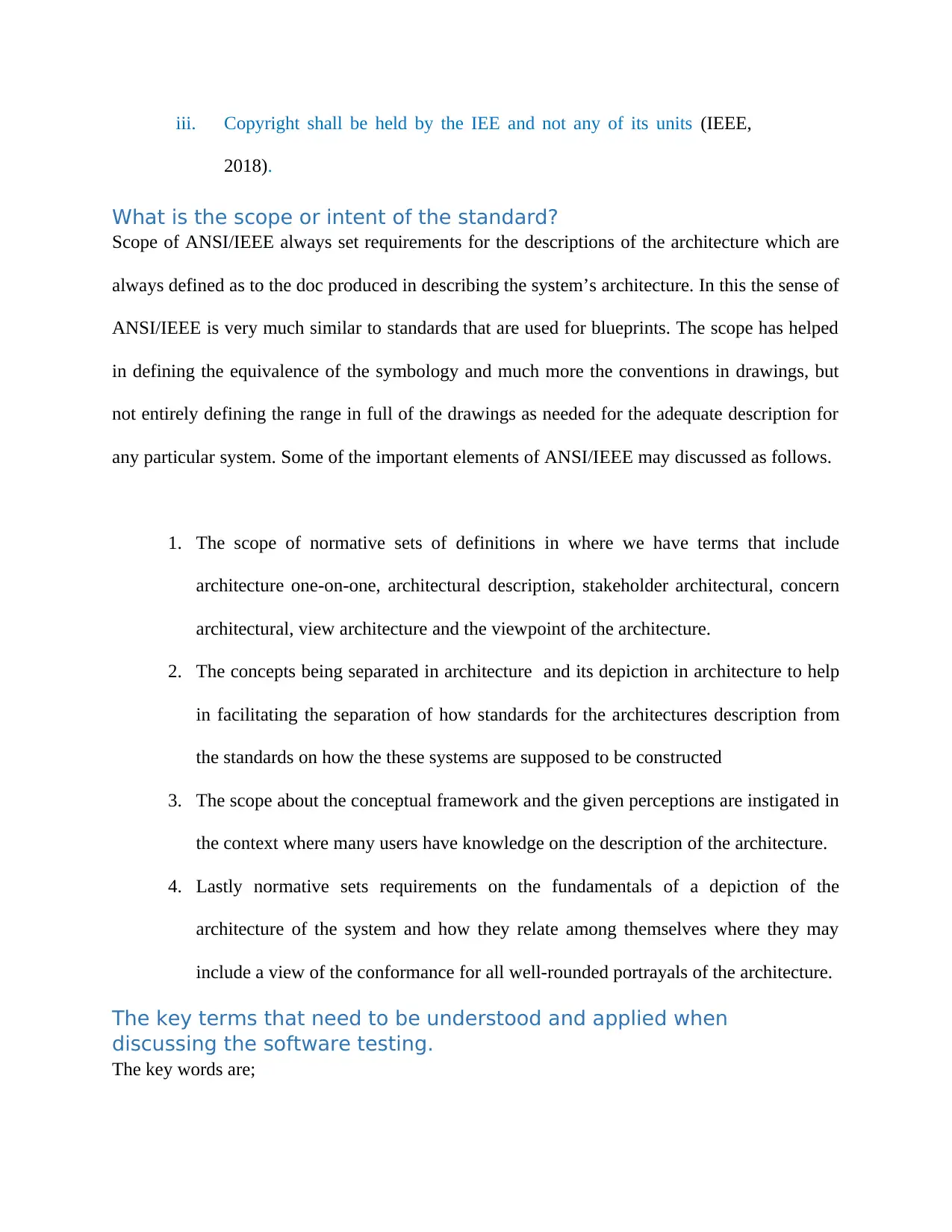
iii. Copyright shall be held by the IEE and not any of its units (IEEE,
2018).
What is the scope or intent of the standard?
Scope of ANSI/IEEE always set requirements for the descriptions of the architecture which are
always defined as to the doc produced in describing the system’s architecture. In this the sense of
ANSI/IEEE is very much similar to standards that are used for blueprints. The scope has helped
in defining the equivalence of the symbology and much more the conventions in drawings, but
not entirely defining the range in full of the drawings as needed for the adequate description for
any particular system. Some of the important elements of ANSI/IEEE may discussed as follows.
1. The scope of normative sets of definitions in where we have terms that include
architecture one-on-one, architectural description, stakeholder architectural, concern
architectural, view architecture and the viewpoint of the architecture.
2. The concepts being separated in architecture and its depiction in architecture to help
in facilitating the separation of how standards for the architectures description from
the standards on how the these systems are supposed to be constructed
3. The scope about the conceptual framework and the given perceptions are instigated in
the context where many users have knowledge on the description of the architecture.
4. Lastly normative sets requirements on the fundamentals of a depiction of the
architecture of the system and how they relate among themselves where they may
include a view of the conformance for all well-rounded portrayals of the architecture.
The key terms that need to be understood and applied when
discussing the software testing.
The key words are;
2018).
What is the scope or intent of the standard?
Scope of ANSI/IEEE always set requirements for the descriptions of the architecture which are
always defined as to the doc produced in describing the system’s architecture. In this the sense of
ANSI/IEEE is very much similar to standards that are used for blueprints. The scope has helped
in defining the equivalence of the symbology and much more the conventions in drawings, but
not entirely defining the range in full of the drawings as needed for the adequate description for
any particular system. Some of the important elements of ANSI/IEEE may discussed as follows.
1. The scope of normative sets of definitions in where we have terms that include
architecture one-on-one, architectural description, stakeholder architectural, concern
architectural, view architecture and the viewpoint of the architecture.
2. The concepts being separated in architecture and its depiction in architecture to help
in facilitating the separation of how standards for the architectures description from
the standards on how the these systems are supposed to be constructed
3. The scope about the conceptual framework and the given perceptions are instigated in
the context where many users have knowledge on the description of the architecture.
4. Lastly normative sets requirements on the fundamentals of a depiction of the
architecture of the system and how they relate among themselves where they may
include a view of the conformance for all well-rounded portrayals of the architecture.
The key terms that need to be understood and applied when
discussing the software testing.
The key words are;
Paraphrase This Document
Need a fresh take? Get an instant paraphrase of this document with our AI Paraphraser
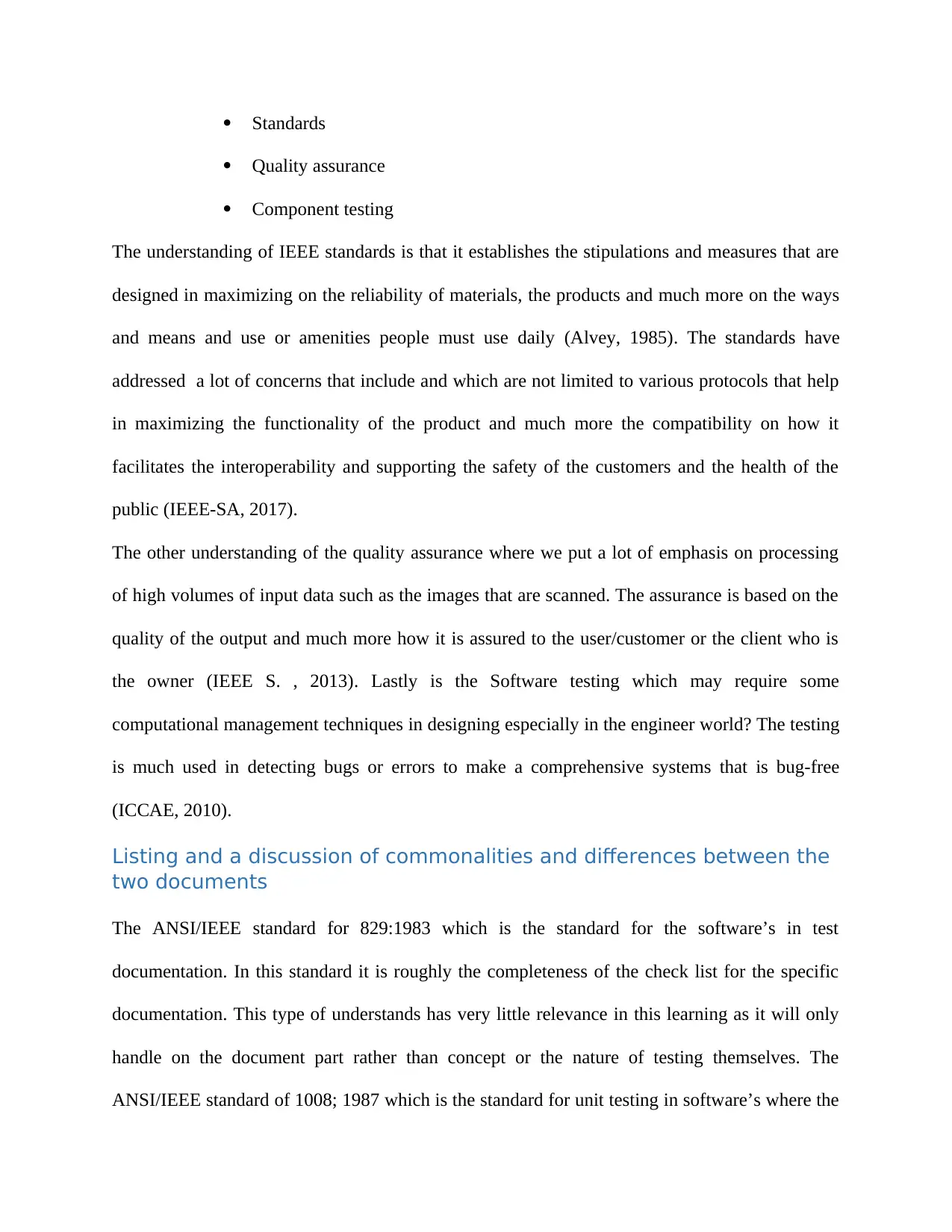
Standards
Quality assurance
Component testing
The understanding of IEEE standards is that it establishes the stipulations and measures that are
designed in maximizing on the reliability of materials, the products and much more on the ways
and means and use or amenities people must use daily (Alvey, 1985). The standards have
addressed a lot of concerns that include and which are not limited to various protocols that help
in maximizing the functionality of the product and much more the compatibility on how it
facilitates the interoperability and supporting the safety of the customers and the health of the
public (IEEE-SA, 2017).
The other understanding of the quality assurance where we put a lot of emphasis on processing
of high volumes of input data such as the images that are scanned. The assurance is based on the
quality of the output and much more how it is assured to the user/customer or the client who is
the owner (IEEE S. , 2013). Lastly is the Software testing which may require some
computational management techniques in designing especially in the engineer world? The testing
is much used in detecting bugs or errors to make a comprehensive systems that is bug-free
(ICCAE, 2010).
Listing and a discussion of commonalities and differences between the
two documents
The ANSI/IEEE standard for 829:1983 which is the standard for the software’s in test
documentation. In this standard it is roughly the completeness of the check list for the specific
documentation. This type of understands has very little relevance in this learning as it will only
handle on the document part rather than concept or the nature of testing themselves. The
ANSI/IEEE standard of 1008; 1987 which is the standard for unit testing in software’s where the
Quality assurance
Component testing
The understanding of IEEE standards is that it establishes the stipulations and measures that are
designed in maximizing on the reliability of materials, the products and much more on the ways
and means and use or amenities people must use daily (Alvey, 1985). The standards have
addressed a lot of concerns that include and which are not limited to various protocols that help
in maximizing the functionality of the product and much more the compatibility on how it
facilitates the interoperability and supporting the safety of the customers and the health of the
public (IEEE-SA, 2017).
The other understanding of the quality assurance where we put a lot of emphasis on processing
of high volumes of input data such as the images that are scanned. The assurance is based on the
quality of the output and much more how it is assured to the user/customer or the client who is
the owner (IEEE S. , 2013). Lastly is the Software testing which may require some
computational management techniques in designing especially in the engineer world? The testing
is much used in detecting bugs or errors to make a comprehensive systems that is bug-free
(ICCAE, 2010).
Listing and a discussion of commonalities and differences between the
two documents
The ANSI/IEEE standard for 829:1983 which is the standard for the software’s in test
documentation. In this standard it is roughly the completeness of the check list for the specific
documentation. This type of understands has very little relevance in this learning as it will only
handle on the document part rather than concept or the nature of testing themselves. The
ANSI/IEEE standard of 1008; 1987 which is the standard for unit testing in software’s where the
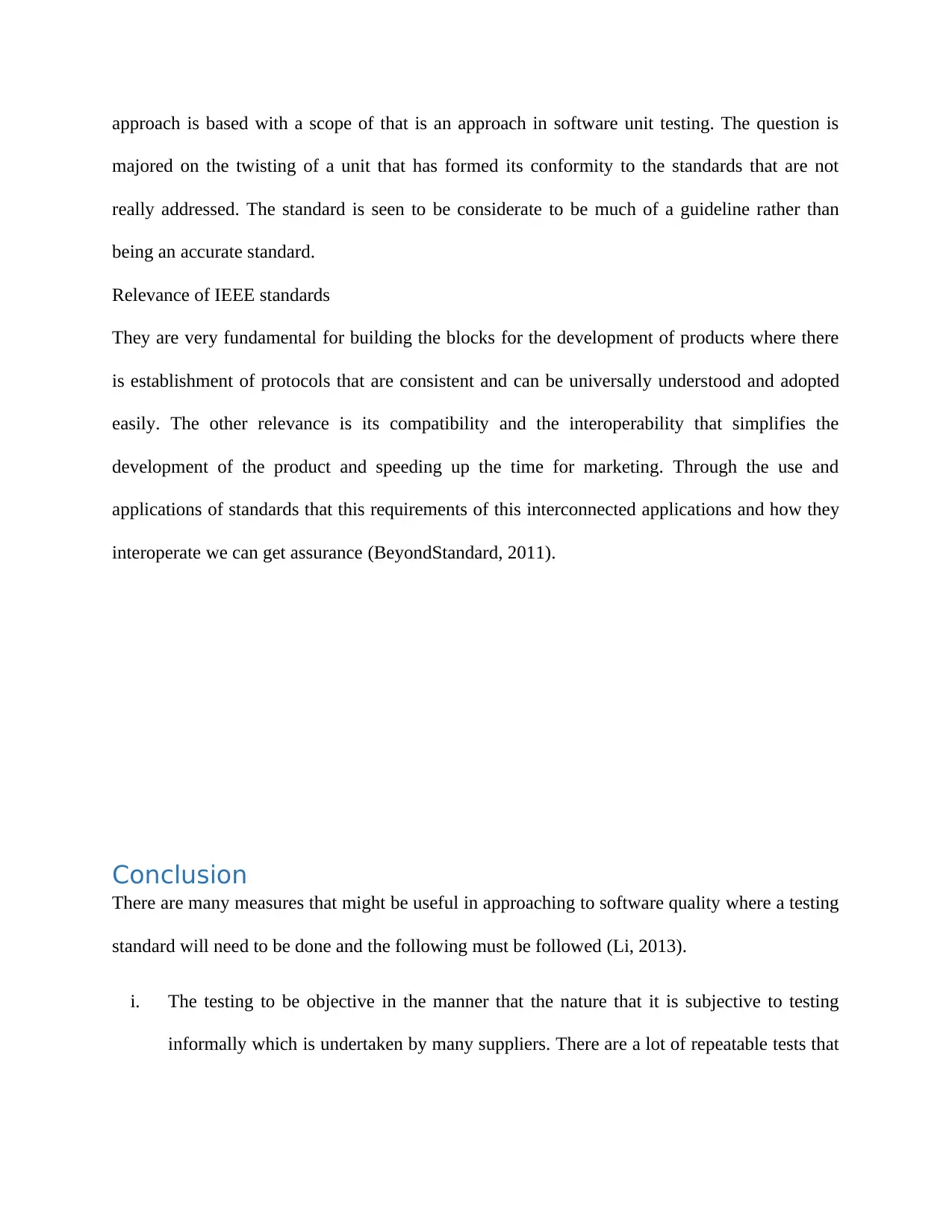
approach is based with a scope of that is an approach in software unit testing. The question is
majored on the twisting of a unit that has formed its conformity to the standards that are not
really addressed. The standard is seen to be considerate to be much of a guideline rather than
being an accurate standard.
Relevance of IEEE standards
They are very fundamental for building the blocks for the development of products where there
is establishment of protocols that are consistent and can be universally understood and adopted
easily. The other relevance is its compatibility and the interoperability that simplifies the
development of the product and speeding up the time for marketing. Through the use and
applications of standards that this requirements of this interconnected applications and how they
interoperate we can get assurance (BeyondStandard, 2011).
Conclusion
There are many measures that might be useful in approaching to software quality where a testing
standard will need to be done and the following must be followed (Li, 2013).
i. The testing to be objective in the manner that the nature that it is subjective to testing
informally which is undertaken by many suppliers. There are a lot of repeatable tests that
majored on the twisting of a unit that has formed its conformity to the standards that are not
really addressed. The standard is seen to be considerate to be much of a guideline rather than
being an accurate standard.
Relevance of IEEE standards
They are very fundamental for building the blocks for the development of products where there
is establishment of protocols that are consistent and can be universally understood and adopted
easily. The other relevance is its compatibility and the interoperability that simplifies the
development of the product and speeding up the time for marketing. Through the use and
applications of standards that this requirements of this interconnected applications and how they
interoperate we can get assurance (BeyondStandard, 2011).
Conclusion
There are many measures that might be useful in approaching to software quality where a testing
standard will need to be done and the following must be followed (Li, 2013).
i. The testing to be objective in the manner that the nature that it is subjective to testing
informally which is undertaken by many suppliers. There are a lot of repeatable tests that
⊘ This is a preview!⊘
Do you want full access?
Subscribe today to unlock all pages.

Trusted by 1+ million students worldwide
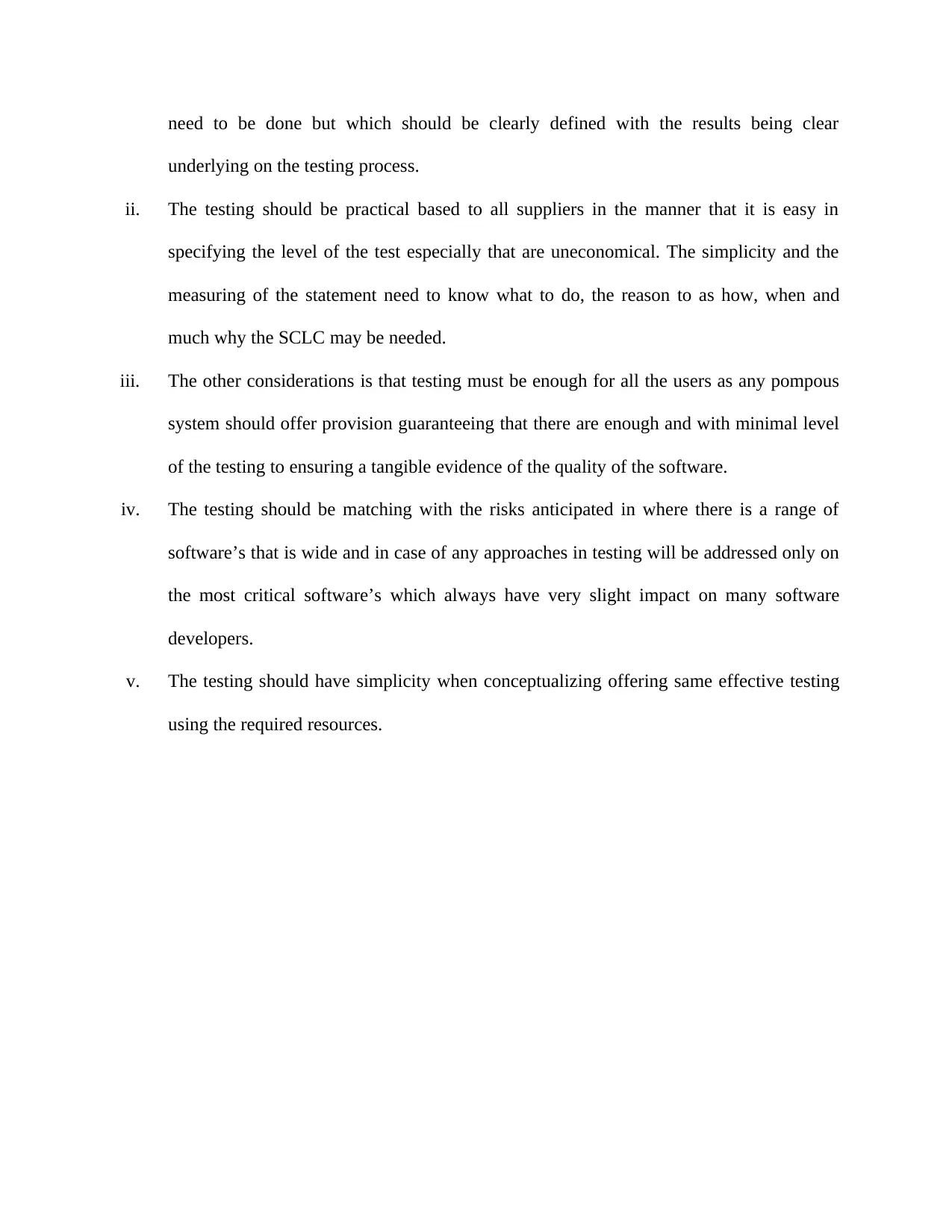
need to be done but which should be clearly defined with the results being clear
underlying on the testing process.
ii. The testing should be practical based to all suppliers in the manner that it is easy in
specifying the level of the test especially that are uneconomical. The simplicity and the
measuring of the statement need to know what to do, the reason to as how, when and
much why the SCLC may be needed.
iii. The other considerations is that testing must be enough for all the users as any pompous
system should offer provision guaranteeing that there are enough and with minimal level
of the testing to ensuring a tangible evidence of the quality of the software.
iv. The testing should be matching with the risks anticipated in where there is a range of
software’s that is wide and in case of any approaches in testing will be addressed only on
the most critical software’s which always have very slight impact on many software
developers.
v. The testing should have simplicity when conceptualizing offering same effective testing
using the required resources.
underlying on the testing process.
ii. The testing should be practical based to all suppliers in the manner that it is easy in
specifying the level of the test especially that are uneconomical. The simplicity and the
measuring of the statement need to know what to do, the reason to as how, when and
much why the SCLC may be needed.
iii. The other considerations is that testing must be enough for all the users as any pompous
system should offer provision guaranteeing that there are enough and with minimal level
of the testing to ensuring a tangible evidence of the quality of the software.
iv. The testing should be matching with the risks anticipated in where there is a range of
software’s that is wide and in case of any approaches in testing will be addressed only on
the most critical software’s which always have very slight impact on many software
developers.
v. The testing should have simplicity when conceptualizing offering same effective testing
using the required resources.
Paraphrase This Document
Need a fresh take? Get an instant paraphrase of this document with our AI Paraphraser
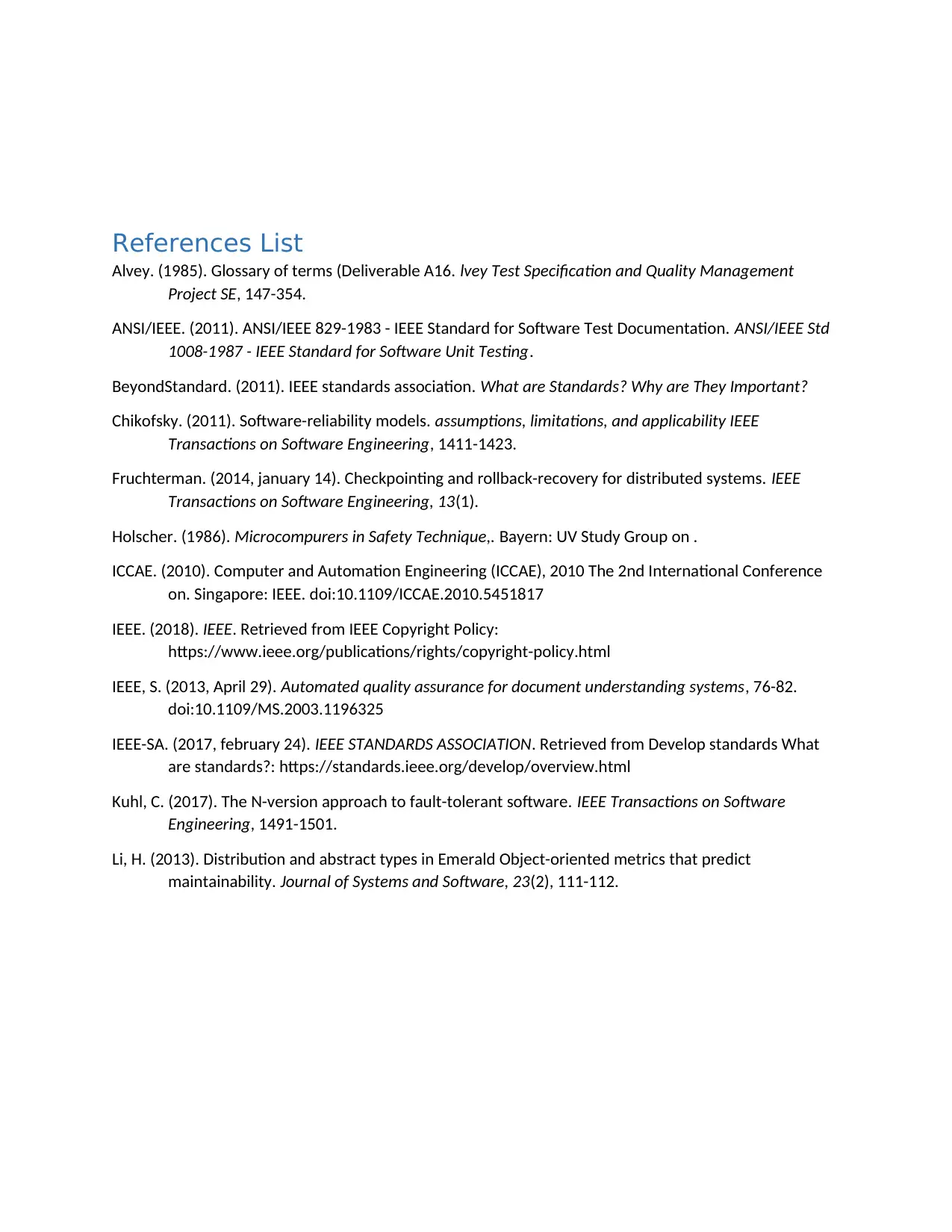
References List
Alvey. (1985). Glossary of terms (Deliverable A16. lvey Test Specification and Quality Management
Project SE, 147-354.
ANSI/IEEE. (2011). ANSI/IEEE 829-1983 - IEEE Standard for Software Test Documentation. ANSI/IEEE Std
1008-1987 - IEEE Standard for Software Unit Testing.
BeyondStandard. (2011). IEEE standards association. What are Standards? Why are They Important?
Chikofsky. (2011). Software-reliability models. assumptions, limitations, and applicability IEEE
Transactions on Software Engineering, 1411-1423.
Fruchterman. (2014, january 14). Checkpointing and rollback-recovery for distributed systems. IEEE
Transactions on Software Engineering, 13(1).
Holscher. (1986). Microcompurers in Safety Technique,. Bayern: UV Study Group on .
ICCAE. (2010). Computer and Automation Engineering (ICCAE), 2010 The 2nd International Conference
on. Singapore: IEEE. doi:10.1109/ICCAE.2010.5451817
IEEE. (2018). IEEE. Retrieved from IEEE Copyright Policy:
https://www.ieee.org/publications/rights/copyright-policy.html
IEEE, S. (2013, April 29). Automated quality assurance for document understanding systems, 76-82.
doi:10.1109/MS.2003.1196325
IEEE-SA. (2017, february 24). IEEE STANDARDS ASSOCIATION. Retrieved from Develop standards What
are standards?: https://standards.ieee.org/develop/overview.html
Kuhl, C. (2017). The N-version approach to fault-tolerant software. IEEE Transactions on Software
Engineering, 1491-1501.
Li, H. (2013). Distribution and abstract types in Emerald Object-oriented metrics that predict
maintainability. Journal of Systems and Software, 23(2), 111-112.
Alvey. (1985). Glossary of terms (Deliverable A16. lvey Test Specification and Quality Management
Project SE, 147-354.
ANSI/IEEE. (2011). ANSI/IEEE 829-1983 - IEEE Standard for Software Test Documentation. ANSI/IEEE Std
1008-1987 - IEEE Standard for Software Unit Testing.
BeyondStandard. (2011). IEEE standards association. What are Standards? Why are They Important?
Chikofsky. (2011). Software-reliability models. assumptions, limitations, and applicability IEEE
Transactions on Software Engineering, 1411-1423.
Fruchterman. (2014, january 14). Checkpointing and rollback-recovery for distributed systems. IEEE
Transactions on Software Engineering, 13(1).
Holscher. (1986). Microcompurers in Safety Technique,. Bayern: UV Study Group on .
ICCAE. (2010). Computer and Automation Engineering (ICCAE), 2010 The 2nd International Conference
on. Singapore: IEEE. doi:10.1109/ICCAE.2010.5451817
IEEE. (2018). IEEE. Retrieved from IEEE Copyright Policy:
https://www.ieee.org/publications/rights/copyright-policy.html
IEEE, S. (2013, April 29). Automated quality assurance for document understanding systems, 76-82.
doi:10.1109/MS.2003.1196325
IEEE-SA. (2017, february 24). IEEE STANDARDS ASSOCIATION. Retrieved from Develop standards What
are standards?: https://standards.ieee.org/develop/overview.html
Kuhl, C. (2017). The N-version approach to fault-tolerant software. IEEE Transactions on Software
Engineering, 1491-1501.
Li, H. (2013). Distribution and abstract types in Emerald Object-oriented metrics that predict
maintainability. Journal of Systems and Software, 23(2), 111-112.
1 out of 8
Related Documents
Your All-in-One AI-Powered Toolkit for Academic Success.
+13062052269
info@desklib.com
Available 24*7 on WhatsApp / Email
![[object Object]](/_next/static/media/star-bottom.7253800d.svg)
Unlock your academic potential
Copyright © 2020–2025 A2Z Services. All Rights Reserved. Developed and managed by ZUCOL.




